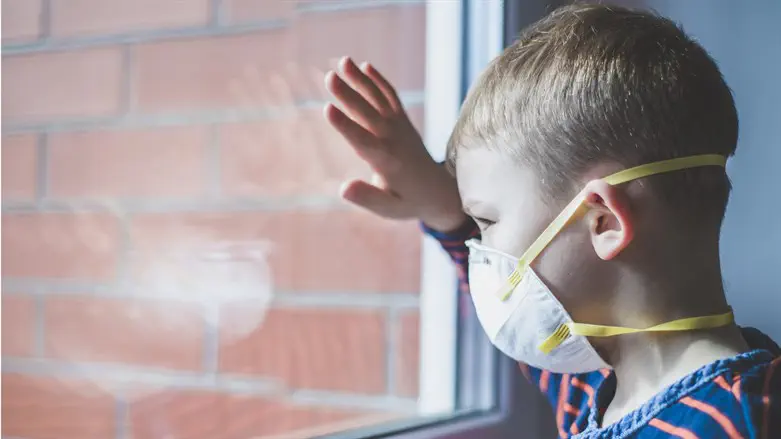
A new article published in The Lancet Psychiatry revealed that those who recovered from COVID-19 are at increased risk of psychotic disorders, dementia, and epilepsy, than those recovering from other respiratory illnesses - for a period of two years from recovery.
In the longitudinal cohort study, which was based on electronic patient records, researchers matched individuals who had a recorded case of COVID-19 using propensity scores to individuals with another respiratory infection and without COVID-19 in the database, over a follow-up period of two years.
The study matched participants based on demographic factors, risk factors for COVID-19 and severe COVID-19 illness, and vaccination status, and analyses were stratified by age group: children, adults, and older adults, as well as date of diagnosis.
Researchers assessed the risks of 14 neurological and psychiatric diagnoses after SARS-CoV-2 infection and compared them with the matched comparator cohort. They also estimated how many people died after a neurological or psychiatric diagnosis during follow-up in each age group, and compared matched cohorts of patients diagnosed with COVID-19 directly before and after the emergence of the alpha (B.1.1.7), delta (B.1.617.2), and omicron (B.1.1.529) variants.
In the study, the researchers, identified a total of 1,487,712 patients with a recorded diagnosis of COVID-19 during the study period, of whom 1,284,437 were adequately matched with an equal number of patients with another respiratory infection.
The results showed that among the COVID-19 sufferers, the risks of the common psychiatric disorders returned to baseline after 1–2 months, and afterwards reached an equal overall incidence to the matched comparison group, but the risks of cognitive deficit, dementia, psychotic disorders, and epilepsy or seizures were still increased at the end of the 2-year follow-up period.
The results also showed that in the first six months after a COVID-19 infection, children "were not at an increased risk of mood or anxiety disorders, but did have an increased risk of cognitive deficit, insomnia, intracranial haemorrhage, ischaemic stroke, nerve, nerve root, and plexus disorders, psychotic disorders, and epilepsy or seizures."
"Unlike adults, cognitive deficit in children had a finite risk horizon (75 days) and a finite time to equal incidence (491 days)," the study noted, adding that, "A sizeable proportion of older adults who received a neurological or psychiatric diagnosis, in either cohort, subsequently died, especially those diagnosed with dementia or epilepsy or seizures."
"These outcomes followed an ongoing risk trajectory, wherein new diagnoses were still being made more frequently after COVID-19 diagnosis than after a diagnosis of another respiratory infection up to 2 years after the index event. ... Intracranial haemorrhage and nerve, nerve root, and plexus disorder had an ongoing risk trajectory in children, such that they did not reach a risk horizon (nor therefore a time to equal incidence) within 2 years."
"The significantly higher 2-year cumulative incidences observed after COVID-19 (vs another respiratory infection) for outcomes with persistent or ongoing risk trajectories were reflected differently across age groups: the difference in incidence of cognitive deficit and dementia between cohorts was more noticeable for older adults than for adults or children; that of myoneural junction or muscle diseases was predominantly seen in children and adults but not older adults; that of epilepsy or seizures was significant only in children, and the risk of psychotic disorder was more evident for children and older adults than for adults."
It added, "Risk profiles were similar just before versus just after the emergence of the alpha variant (n=47 675 in each cohort). Just after (vs just before) the emergence of the delta variant (n=44 835 in each cohort), increased risks of ischaemic stroke, epilepsy or seizures, cognitive deficit, insomnia, and anxiety disorders were observed, compounded by an increased death rate. With omicron (n=39 845 in each cohort), there was a lower death rate than just before emergence of the variant, but the risks of neurological and psychiatric outcomes remained similar."
"Children have a more benign overall profile of psychiatric risk than do adults and older adults, but their sustained higher risk of some diagnoses is of concern," the researchers explained. "The fact that neurological and psychiatric outcomes were similar during the delta and omicron waves indicates that the burden on the health-care system might continue even with variants that are less severe in other respects."
"Our findings are relevant to understanding individual-level and population-level risks of neurological and psychiatric disorders after SARS-CoV-2 infection and can help inform our responses to them."
At the same time, they emphasized that, "More than 2 years after the first case was diagnosed ... we do not know if or when the risks of different post-COVID-19 outcomes return to baseline. This information is important to patients (who want to know when they can stop worrying about potential complications of their SARS-CoV-2 infection), clinicians (who need to know whether a clinical presentation is plausibly attributable to a post-COVID condition), and health policy makers (who must plan appropriate service provision). Previous studies on the neurological and psychiatric sequelae of COVID-19 did not investigate this question."
"To our knowledge, this is the first study with a comparator cohort that assesses the risks of a range of neurological and psychiatric outcomes of COVID-19 up to 2 years after the index SARS-CoV-2 infection.
"We found that the risks of post-COVID neurological and psychiatric outcomes follow different trajectories: the risk of cognitive deficit, dementia, psychotic disorder, and epilepsy or seizures remain elevated 2 years after SARS-CoV-2 infection, while the risks of other diagnoses (notably, mood and anxiety disorders) subside after 1–2 months and show no overall excess over the whole 2-year follow-up.
"We also found that risk trajectories differ somewhat in children: they are not at an increased risk of mood or anxiety disorders (even over the first 6 months) and their risk of cognitive deficit is transient, but they share adults’ risk of several other diagnoses and are notably at risk of epilepsy or seizures. Finally, we found that the risks of neurological and psychiatric outcomes remain similar after the emergence of the omicron (B.1.1.529) variant as with the delta (B.1.617.2) variant, but are offset by a significantly lower death rate."
"The persisting increased risk of post-COVID-19 cognitive deficit, dementia, psychotic disorders, and epilepsy or seizures 2 years after the index infection calls for enhanced service provision to diagnose and manage these sequelae, and research to understand the mechanisms. The differing profile of post-COVID-19 neurological and psychiatric diagnoses in children informs the risk–benefit association of policies aimed at preventing COVID-19 in paediatric populations and suggests that underlying mechanisms might in part be different from those in adults. The observation of comparable neurological and psychiatric risks just after (compared with just before) emergence of the omicron variant suggests an ongoing neuropsychiatric burden of COVID-19 even with variants that lead to otherwise less severe disease."
The researchers emphasized, "The risk profile in different age strata, especially in children, has not been well characterized. Neurological manifestations of COVID-19 in paediatric populations (aged <18 years) have been reported, but only one controlled study has investigated the risk of neurological and psychiatric outcomes after SARS-CoV-2 infection. This study was limited to a 3-month follow-up period and measured neurological and psychiatric outcomes as two broad categories, without reporting the risk of individual diagnoses."
They clarified: "The COVID-19 and other respiratory infection cohorts were stratified by age group (age <18, 18–64, and ≥65 years) and by date of the index events in 2-monthly periods. Within each stratum, cohorts were propensity-score matched (1:1) for 82 covariates: sociodemographic factors and comorbidities representing risk for COVID-19, for more severe COVID-19 illness, or for COVID-19 sequelae, COVID-19 vaccination status, and previous or concurrent use of medications known to be associated with COVID-19 incidence or outcomes (ie, any antipsychotics [and clozapine specifically], any antidepressant [and fluvoxamine specifically], and lithium)."
"Characteristics with a standardized mean difference (SMD) between cohorts lower than 0·1 were considered to be adequately matched," the researchers noted. "As in our previous study, for outcomes that are chronic illnesses (ie, dementia, myoneural junction or muscle disease, and parkinsonism), we excluded patients who had the diagnosis before the index event in the analysis of that outcome."

